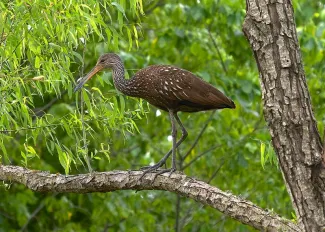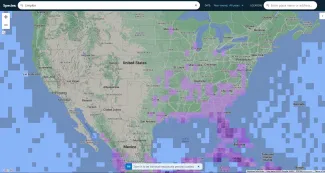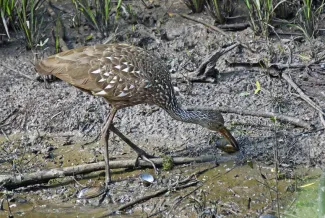A curious bird has made a handful of curious appearances in the state, sparking a rare bird alert in the bird watching community and in the media. At least seven limpkins, a bird most often found in the United States in Florida, have been spotted in Oklahoma this spring, with reports coming from Red Slough Wildlife Management Area, near Idabel, the Mary K. Oxley Nature Center in Tulsa, as well as in Wagoner, Mayes, and Carter counties.
While this is the largest number of birds spotted in Oklahoma at one time, it’s not the first time the species has been documented in the state.
Three years ago, before the first limpkin was recorded in the state, David Arbour, biologist aide for the Wildlife Department, was tracking the limpkin expansion into Louisiana with some of his birding friends and wondered if or when the birds might stray northward into Oklahoma.
“We knew it was possible, but I didn’t expect to see a limpkin at Red Slough the very next year,” Arbour said. “I got an early start to my bird survey in July 2020 and saw a large bird leaving the heronry on Pintail Lake at first light. It was probably 200 yards away, but I could see it kept its neck extended in flight and had a floppy flight. My first impression was that it may be a limpkin, but great blue herons will sometimes fly with an extended neck. I worked my way down to the area where I saw the bird land, and a great blue heron flew up and away. So, I wrote down the heron and continued on with the survey.”

The limpkin is a long-legged and long-necked wading bird most similar to rails and cranes in shape. Birds in more northern population have a speckled appearance on the neck and body.
Two hours later, Arbour was leaving the observation tower after the survey had concluded but couldn’t get the earlier bird off his mind.
“I knew limpkins responded well to callback, so I decided to play a limpkin call at the edge of the marsh where I saw the bird land. Almost immediately, a limpkin buzzed my head. It disappeared in the willows, then flew right in front of me and gave me the best look.”
That morning, Arbour put out an alert to the birding community and was later joined by two birders, Matt White from Texas, and Steve Metz from Oklahoma. The trio searched for the bird and finally got a photograph as the bird returned to the heronry at last light.
“I always have my eyes and ears open for something out of the ordinary. And I always have a camera ready in the truck. You never know when you’re going to run across something new,” Arbour said.
Since that first limpkin record in 2020, Arbour and other birders have documented the following Oklahoma records:

This eBird range map shows in purple the locations of several limpkin sightings through the years.
- On July 9, 2020, Arbour reported the first Oklahoma limpkin during a bird survey at Red Slough WMA. The bird was spotted at a heron rookery on Pintail Lake.
- On April 12, 2021, Arbour reported the second known Oklahoma occurrence of a limpkin, also at Red Slough WMA.
- On April 21, 2022, Arbour reported the third Oklahoma limpkin occurrence, again at Red Slough WMA. Birders have reported up to two limpkins at this location through June.
- On May 11, 2022, multiple birders reported a limpkin at the Mary K. Oxley Nature Center in Tulsa. Since then, an additional two birds have arrived on the area.
- On June 18, 2022, a birder reported a limpkin in Carter County.
Limpkins have long been considered “vagrants” that occasionally wander outside of their natural known range; several records occur in Gulf states, but also in Tennessee, Virginia, Maryland, New Jersey, Minnesota, and Nova Scotia. Reports of those wandering birds are typically of single individuals or small groups and are short-lived in duration. But the breeding range also appears to be expanding into Louisiana, seeming to follow, at least in part, a continued invasion of non-native apple snails.
Limpkins are considered apple snail specialists, and while one apple snail is native to Florida, that species cannot be found in Louisiana. And no apple snail species can be found in Oklahoma. Instead, the birds appear to be feeding on freshwater mussels while in our state. Limpkins will wade in mostly shallow water, collect the bivalves, and then return to shore to crack the shells and extract the meat with their specialized bills.

Oklahoma’s “limpkin invasion” is a great example of how nature enthusiasts can contribute to science by sharing sighting details and photographs of their wild encounters. Biologists can use those details to build a better understanding of the animal’s ecology, and other naturalists can use the reports to plan their next wildlife adventure. Sightings of Oklahoma’s natural world can be shared on multiple platforms, including eBird and iNaturalist.